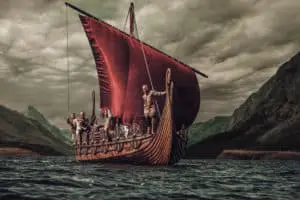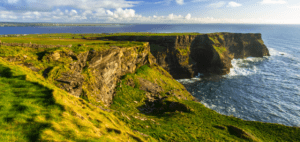The Nomadic Peoples of the Mongolian Steppe: Balancing Heritage with Modernity
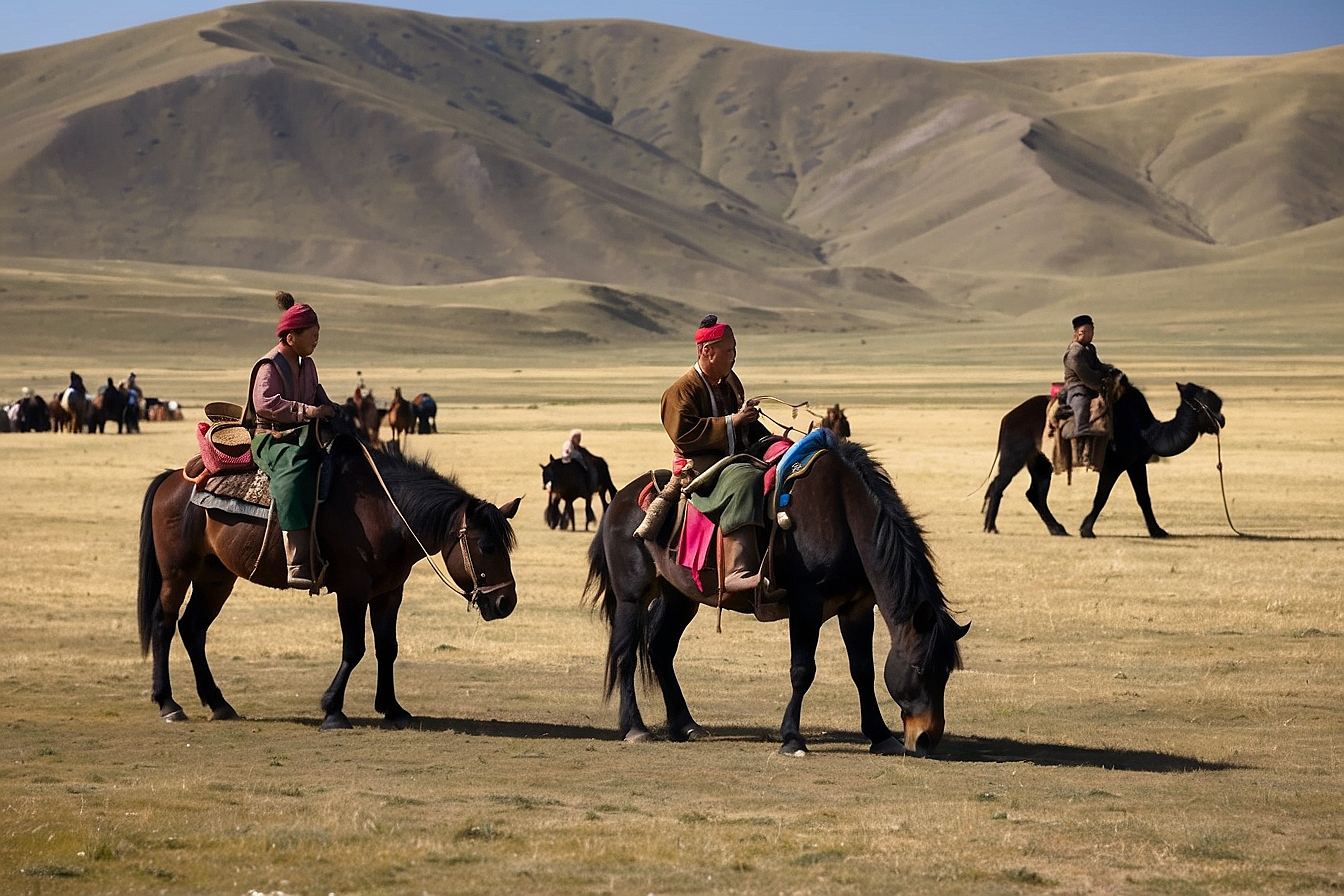
Updated On: April 23, 2024 by Eman Sameh
The Mongolian steppe conjures up images of vast, undulating grasslands and an enduring way of life largely unchanged for centuries. At the heart of this expansive landscape are the nomadic peoples of Mongolia, who have adapted to the harsh, variable climate by honing a lifestyle centred around mobility and resilience. Their culture is deeply intertwined with the steppe itself, with traditions and customs that have sustained them through times of peace and conflict, scarcity and abundance.
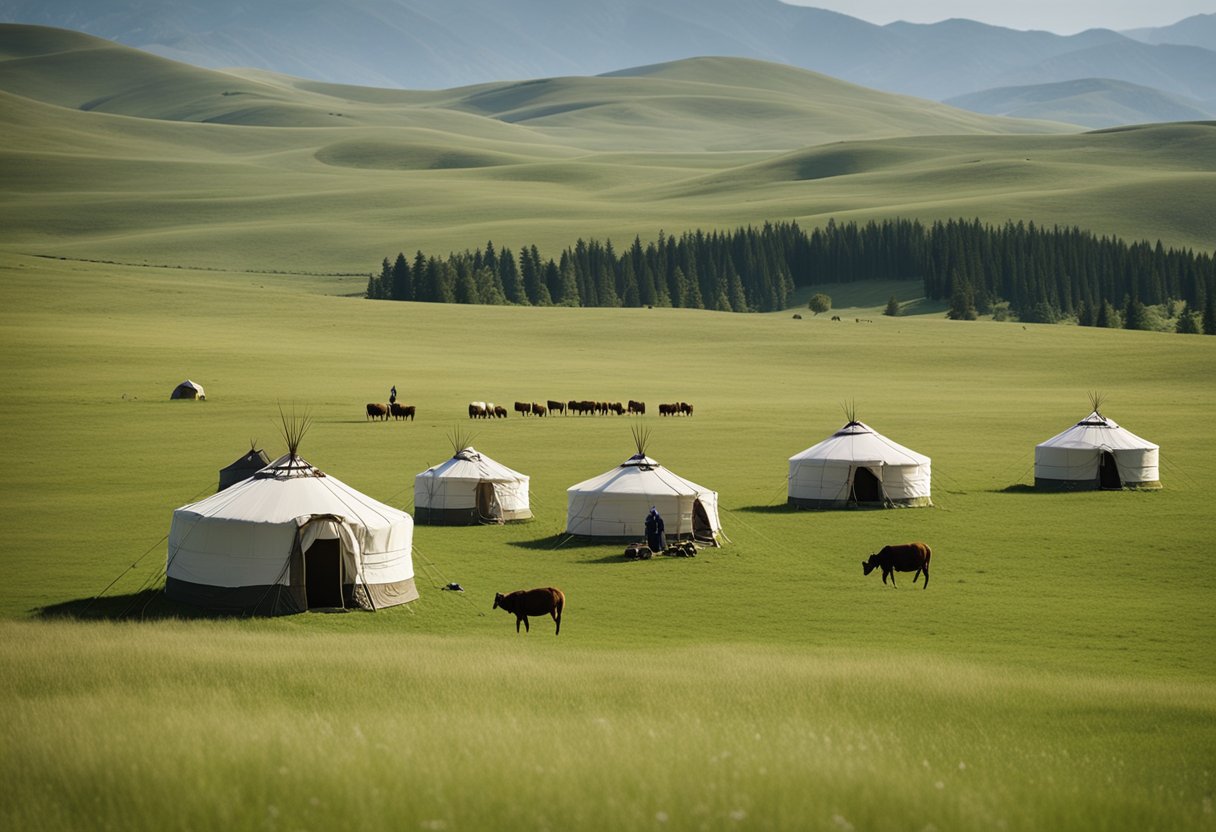
Throughout history, the nomads of the Mongolian steppe have been integral to the socio-economic and geopolitical evolution of the region. Their mastery of horsemanship and their familial and tribal kinships have been pivotal in their military exploits, leaving a significant mark on the stories of human civilisation. Yet, this way of life is not resistant to change. In the face of modern challenges and the growing global influence, these communities are navigating a fine balance between preserving their cultural heritage and adapting to contemporary society
Historical Genesis of Nomadic Cultures
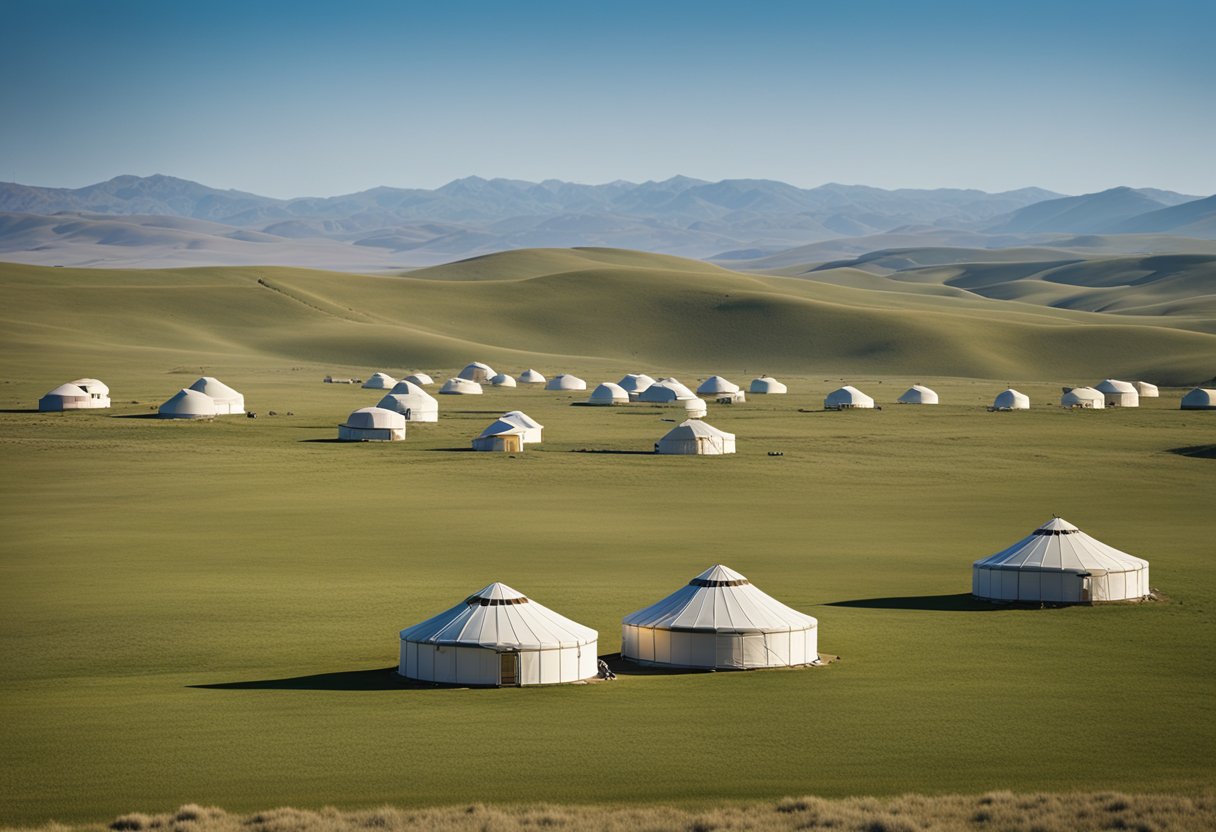
The vast and open Eurasian Steppe has been the cradle of nomadic life for millennia. These expansive grasslands stretch from present-day Hungary to Korea. Central to this expanse is the Mongolian Steppe, a crucial area for the development of nomadic traditions. Our understanding of the area’s early history begins with the latter part of the Bronze Age and progresses through the Iron Age. Over this period, archaeological findings have shone a light on various nomadic cultures such as the Scythians, Saka, Rong, Rouran, Avars, and early Turks.
Nomadic groups, bound by clan ties, travelled across this region in search of pasture for their animals. Tribal confederations came and went, leaving their mark through not just artefacts but also influencing traditions and histories for generations to come. The Xiongnu, for example, created one of the first known nomadic empires during the Iron Age, interacting with the settled Han Dynasty to their south.
Key Entities
- Nomad/Nomadic: Lifestyle adapting to cyclic pasture availability
- Eurasian Steppe/Mongolian Steppe: Vast grasslands housing nomadic cultures
- Bronze Age/Iron Age: Time periods marking significant nomadic cultural development
- Xiongnu: A powerful nomadic confederation
- Clan: The basic social unit in nomadic society
Our collective past with these nomadic peoples is complex and interwoven with the history of settled civilisations. The interactions between steppe nomads and their neighbours often led to significant cultural and economic exchanges. Despite the passage of centuries, the essence of the nomadic spirit still pervades the Mongolian Steppe. The way these cultures adapted and thrived on the harsh steppe continues to intrigue us, offering valuable insights into the resilience and innovation of human societies.
Socio-Economic Structures of Nomadism
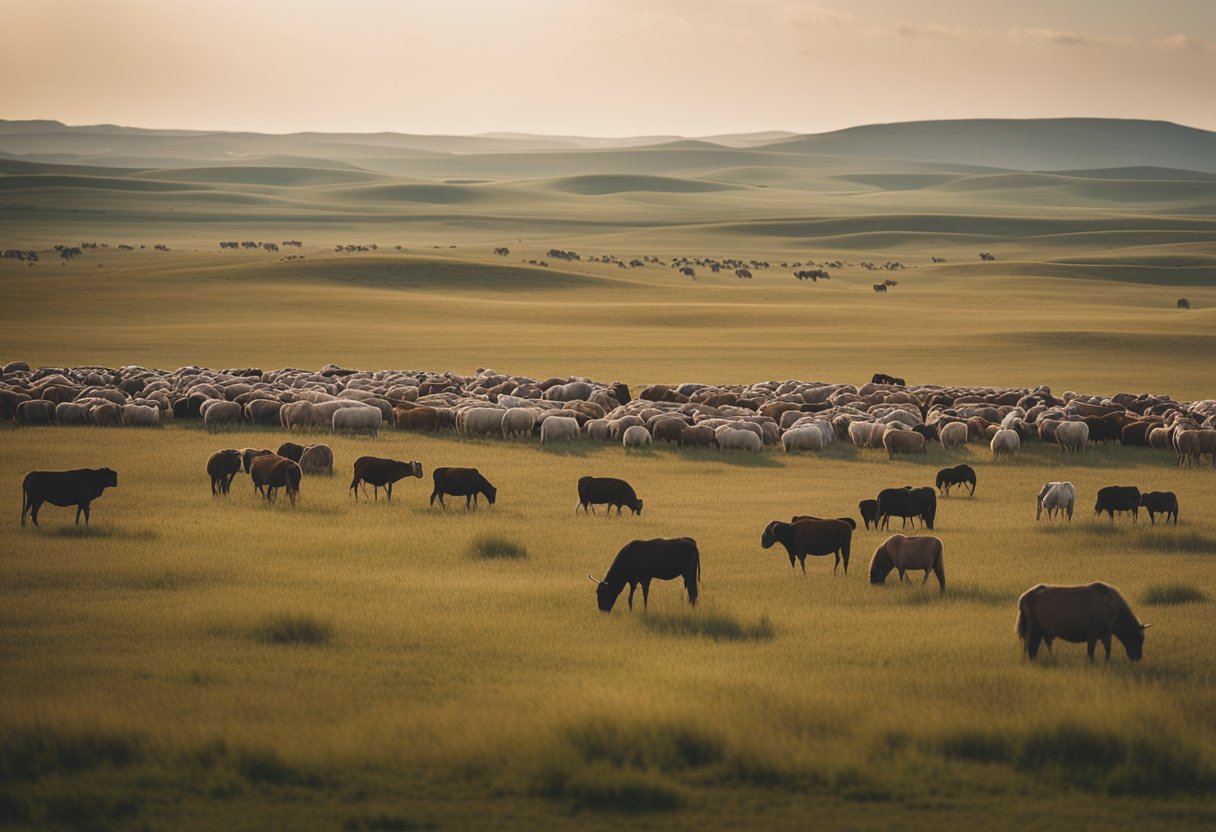
In exploring the socio-economic structures of nomadism, we delve into the ways in which nomadic peoples of the Mongolian Steppe have sustained their livelihoods through pastoralism, trade and tribute systems, and the conscious effort to maintain sustainability within their ecosystems.
Pastoralism and Livelihood
Our nomadic lifestyle pivots on pastoralism, where livestock like cattle, goats, and sheep bear the lifeblood of our economy. These herds are not merely animals; they are assets and providers of dairy, meat, and materials. The ger, a traditional Mongolian home, often sits at the centre of this pastoral life. Our herds roam over extensive rangelands that necessitate a deep, traditional knowledge of the land and its pastures. This itinerant way of managing livestock ensures that the grasslands, key to our herds’ survival, remain sustainable.
Trade and Tribute Systems
In addition to pastoralism, trade is a cornerstone of our economic practice. Historically, nomadic empires were expansive, engaging in trade that was interwoven with systems of tribute. Through these networks, we exchanged goods like livestock, fur, and felt, establishing socio-economic connections, some of which would span great distances. These systems of trade and tribute bolstered our economic strength and facilitated cultural exchanges, influencing a wealth of nomadic societies across the Mongolian Steppe and beyond.
Nomadic Economy and Sustainability
The success of our economy is directly tied to the land’s well-being; hence, sustainability is paramount. It is a delicate process to ensure that our herds thrive without degrading the grasslands. We closely monitor the impact of livestock husbandry on the ecosystem, continuously adapting our practices to support the very environment we depend upon. This sustainable approach reflects our deep-rooted understanding that the Steppe’s vast ecosystem and our traditional nomadic lifestyle are inextricably linked.
Culture and Identity
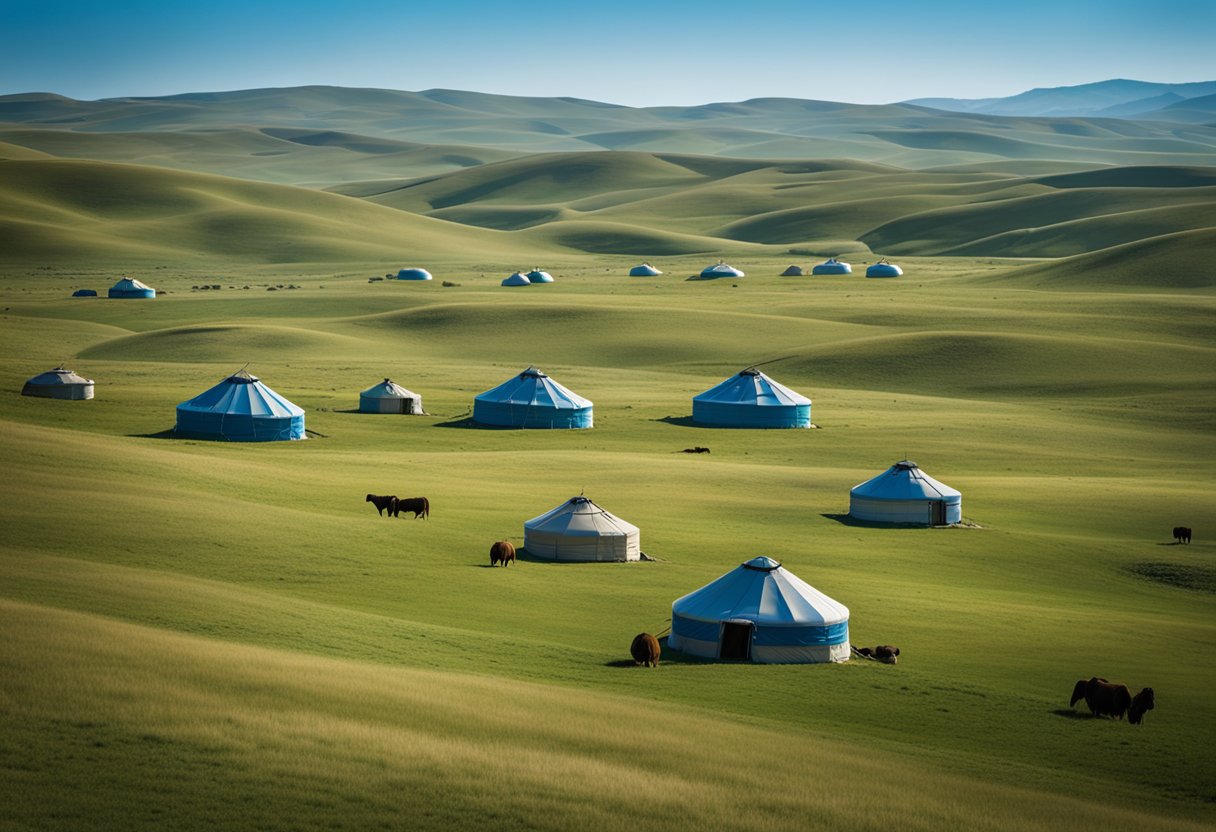
As we explore Mongolia’s vast expanses, we understand that the nomadic peoples have crafted a distinctive culture and identity deeply rooted in their traditions and the landscapes they inhabit.
Rituals and Beliefs
Mongolian nomads maintain a spiritual connection with nature, expressed through ancient rituals and shamanic practices. These ceremonies are pivotal in nomadic life, marking events from marriage to changing seasons. A notable ritual involves the ovoo, a sacred cairn where travellers offer stones, money, or milk, seeking safe passage and good fortune.
Language and Expression
Language serves as the vessel of Mongolian tradition, conveying stories, customs, and the very essence of their identity. Mongolian is written in Cyrillic, though some still use the traditional script. Expressive arts like long songs and throat singing reflect the Mongolian soul, and they resonate across the steppe, reinforcing their cultural narrative.
The Ger: A Centerpiece of Tradition
The ger stands as the enduring symbol of Mongolian heritage. This portable home, synonymous with nomadic life, sustains family and social customs. Its circular design represents the universe; the door always faces south, a custom highlighting their connection to the land and the cosmos. Within these felt walls, generations share tales and maintain a lifestyle that has withstood the test of time.
Mongolia’s Geopolitical Evolution
The evolution of Mongolia’s geopolitical landscape was significantly shaped by the formation of its state and its interactions with neighbouring powers. It’s a history marked by conquests, alliances, and cultural exchanges that have profoundly influenced the region.
Formation of the Mongol State
The birth of the Mongol state can be traced back to the early 13th century when Genghis Khan successfully united the disparate Mongolian tribes into a powerful federation. This was not just a political triumph but also the foundation stone of Mongolia that would have a reverberating impact on northern China, the Jin, and even the Tang Dynasty, leading to an extensive empire that reshaped the geopolitical dynamics of Asia.
Influences and Interactions with Neighbors
Over the centuries, Mongolia did not exist in isolation. Interactions with neighbouring empires and states, such as the Uighurs, Khitan, China, and Russia, have been integral to the country’s evolution. These relationships often fluctuated between conflict and cooperation, significantly influencing Mongolia’s socio-political fabric. The Mongols’ influence stretched far, playing a key role in defining the region’s borders and engaging in frequent exchanges that shaped the political landscape of the Mongolian Steppe.
The Transformation of the Mongolian Steppe
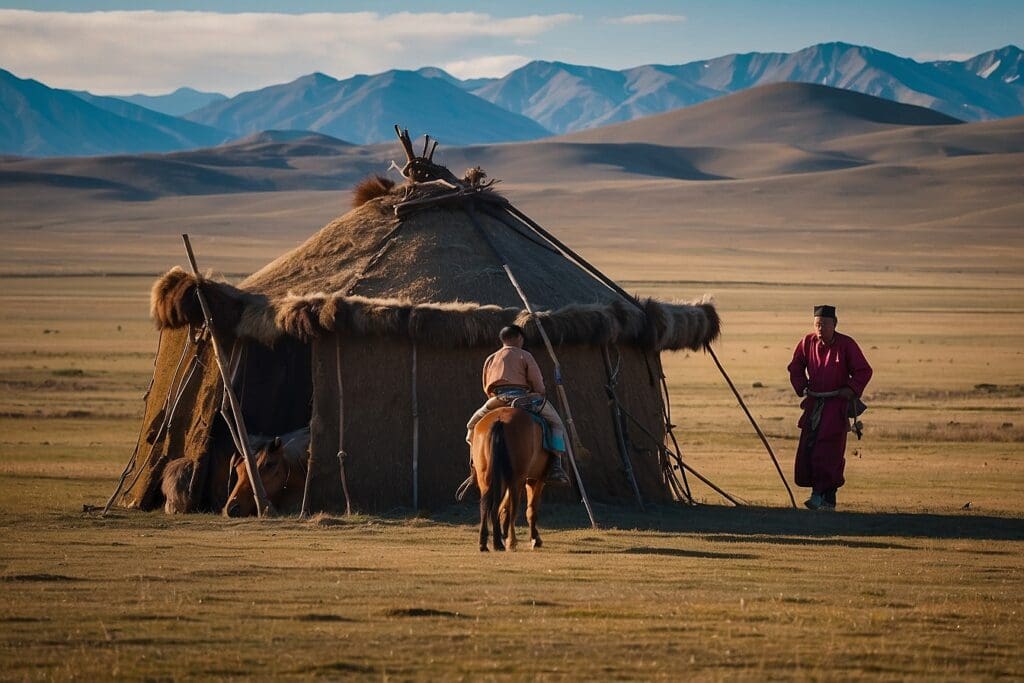
The Mongolian Steppe, a vast expanse stretching across both Mongolia and parts of Kazakhstan, is a region experiencing significant transformation. As we witness urbanisation rapidly expanding, the traditional nomadic lifestyle that once defined this land is adapting to modern challenges.
One of the most notable changes is the move towards electricity and other developments more commonly found in the city. In Mongolia’s capital, Ulaanbaatar, the influx of nomadic peoples has contributed to its growth as an urban centre. This city is a stark contrast to the open steppe, with its bustling streets and connectivity that contrasts with much of the rural landscape.
- Urbanisation:
- Formerly nomadic families gradually settled in Ulaanbaatar.
- Increase in infrastructure and housing developments.
- Electricity:
- Rollout of power grids in rural areas.
- Introduction of solar and wind energy on the steppe.
- Nomadic Lifestyle:
- Shifts due to economic pressures and climate change.
- Preservation of cultural practices alongside modernisation.
Despite these shifts, the spirit of the Mongolian steppe endures. The people balance the necessity of development while maintaining their cultural identity, illustrating a unique ability to evolve with the times. The process of integrating modern conveniences in a respectful manner to the environment and traditional ways of life is indicative of a larger global rhythm, an echo felt as far as Europe in a multitude of contexts.
We encounter a resilient culture, which reflects a broader human experience of adaptation and continuity. Whether across the steppe or within the heart of Ulaanbaatar, the Mongolian ethos remains interwoven with the land, its resources, and the communities that call it home.
Nomadic Tribes and Their Military Exploits
The Mongolian steppe, vast and unforgiving, was home to nomadic tribes renowned for their prowess in warfare. The use of iron for weapons gave these tribes a significant advantage over their enemies, facilitating conquests and the expansion of their domain. The advent of chariot warfare, with light, two-wheeled chariots pulled by horses, marked a pivotal moment in their military history.
The introduction of the saddle and stirrup revolutionised mounted warfare. This innovation allowed the nomads to utilise the full potential of their horseback archers, striking fear into the hearts of sedentary populations.
Nomadic military campaigns were not simply for plunder or territory but also for establishing control over vital trade routes and resources. As such, they frequently clashed with other powerful entities in the region.
A Brief Overview of Their Military Evolution
- Chariots: Provided increased mobility and were used to devastating effect in battles.
- Horse-powered warfare: The backbone of nomadic military might, owing to the mastery of riding and archery.
- Iron weapons: Ensured the tribes had superior equipment in their raids and battles.
- Saddles and stirrups: These greatly improved a rider’s stability and effectiveness in combat.
Enemies of the nomadic tribes often found themselves outmanoeuvred by the combination of speed, military strategy, and technological superiority that these innovations brought to the steppe warriors.
To grasp the extent of their military exploits, we must acknowledge their unyielding spirit and adaptability—a legacy that still echoes through the steppes today.
Technological and Material Culture
The nomadic peoples of the Mongolian Steppe have a resilient material culture, shaped by their necessity to adapt to the harsh, transient nature of their environment. Their technological advancements were historically informed by both necessity and the resources available in the vast steppe.
Iron was a crucial metal for the nomads, used to create weapons, tools, and horse ornaments. The introduction of the wheel enabled the construction of carts that enhanced mobility, pivotal for their nomadic lifestyle. These carts, often pulled by horses, could transport the gers—their portable felt-covered homes—and other belongings across the steppe.
As we unfurl the layers of history through archaeology, we find that Mongolian material culture was not merely functional but also rich in artistry. Bronze artefacts, dating back centuries, testify to the complex societal structures and ceremonies that these nomadic groups observed. Intricate gold objects excavated from burial sites offer us glimpses into the high craftsmanship and status.
| Metal | Use |
|---|---|
| Iron | Weapons, horse equipment, everyday tools |
| Tin | Alloying with copper to create bronze items |
| Gold | Ornamentation, religious, and status symbols |
| Bronze | Artefacts depicting cultural practices |
Our understanding of this material culture is constantly evolving with new discoveries. The technological ingenuity of the Mongolian nomads has ensured the survival of their lineage and the continuation of traditions that span millennia.
Modern Challenges and Adaptations
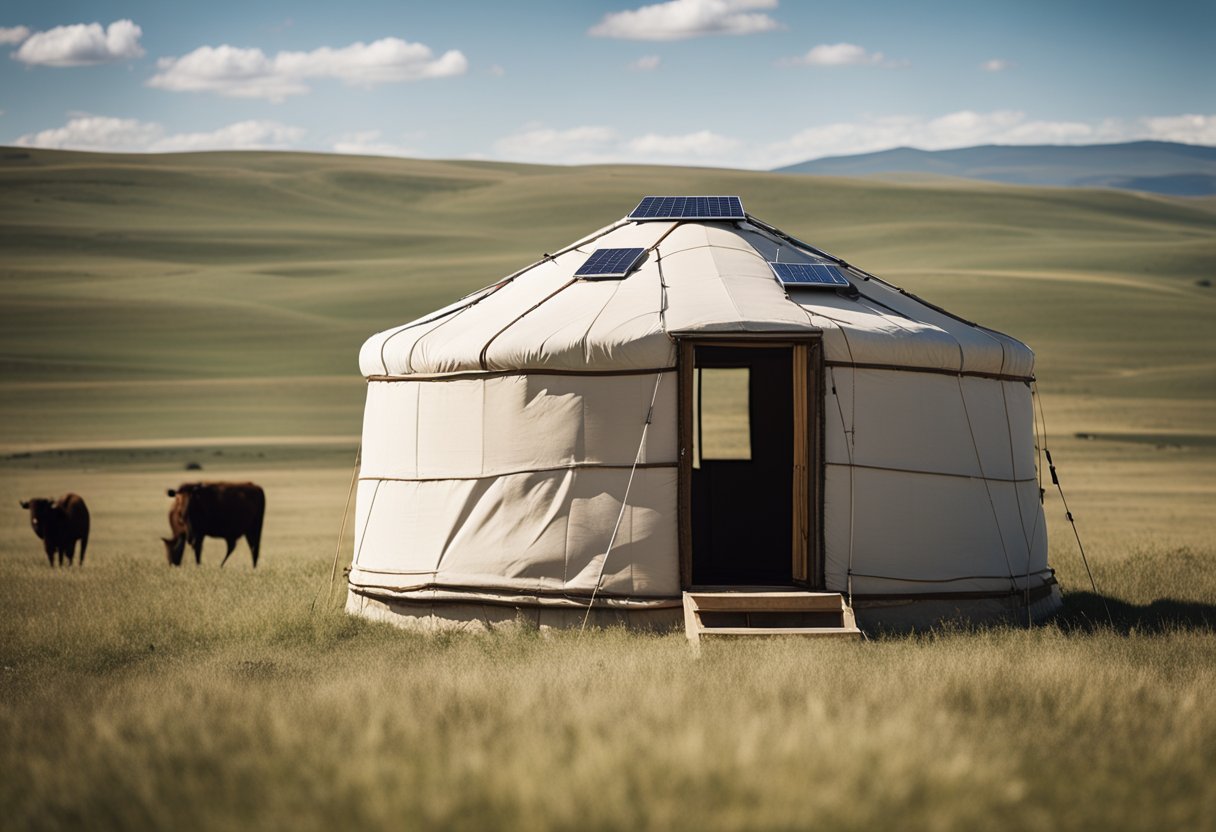
The nomadic peoples of the Mongolian Steppe are facing a precarious balance between maintaining their traditional way of life and adapting to modern challenges. Our exploration here focuses on the environmental concerns and the significant impact of urbanisation on their nomadic lifestyle.
Environmental Concerns and Desertification
Climate change is having a visible impact on the Mongolian Steppe, leading to desertification which, in turn, diminishes the availability of fresh pasture. The increasingly extreme weather conditions—harsher winters and hotter summers—alter the ecosystem that the nomadic peoples and their livestock depend upon. For instance, severe winter events, known locally as dzuds, devastate their herds by limiting access to necessary fodder.
Urbanization and Loss of Pasture
The allure of urbanisation poses its own set of challenges. A growing trend among younger generations of nomads is to migrate towards cities in search of modern conveniences and employment. This shift not only risks the loss of their cultural identity but also exacerbates the decrease in available pastures. As cities expand, the pressures on land increase, often leading to overgrazing and land degradation in the surrounding rural areas. This urban encroachment threatens the sustainability of the traditional nomadic lifestyle and the health of the region’s ecosystems.
Nomadic Ties: Tribes and Kinship
The very essence of the Mongolian steppe is encapsulated in its nomadic lifestyle, weaving a fabric of kinship and tribal affiliations traditional to the region. The nomads of Mongolia, sustaining a way of life that has been passed down for generations, base their social structures on complex networks of clans and tribes.
- Clans: Often tied to lineage and legend, clans are central to nomadic identity. They underpin social organisation and help maintain the balance of power among the diverse groups that roam the steppes.
- Marriages: These are not mere unions between individuals but between clans, serving to strengthen kinship ties and broaden the community network.
Tribes serve a larger collective identity, where multiple clans with shared interests and heritage come together, forming a tight-knit group that shares resources and protection. Such groupings are vital in the wide expanses of the steppe.
The nomadic cultural heritage remains resilient against the tide of modernity. Mongolian identity is rooted in the tales of old, the commonality of their language, and the continuity of their enduring social practices. These aspects ensure that kinship remains at the core of their societal values.
Kinship is not only a matter of blood relations; it is a broad-reaching concept that encompasses allegiance to shared customs and mutual support. This shared bond is crucial for survival in Mongolia’s vast, often inhospitable terrains, as it fosters a cooperative spirit that has enabled these communities to thrive for centuries.
Cultural Heritage and its Preservation
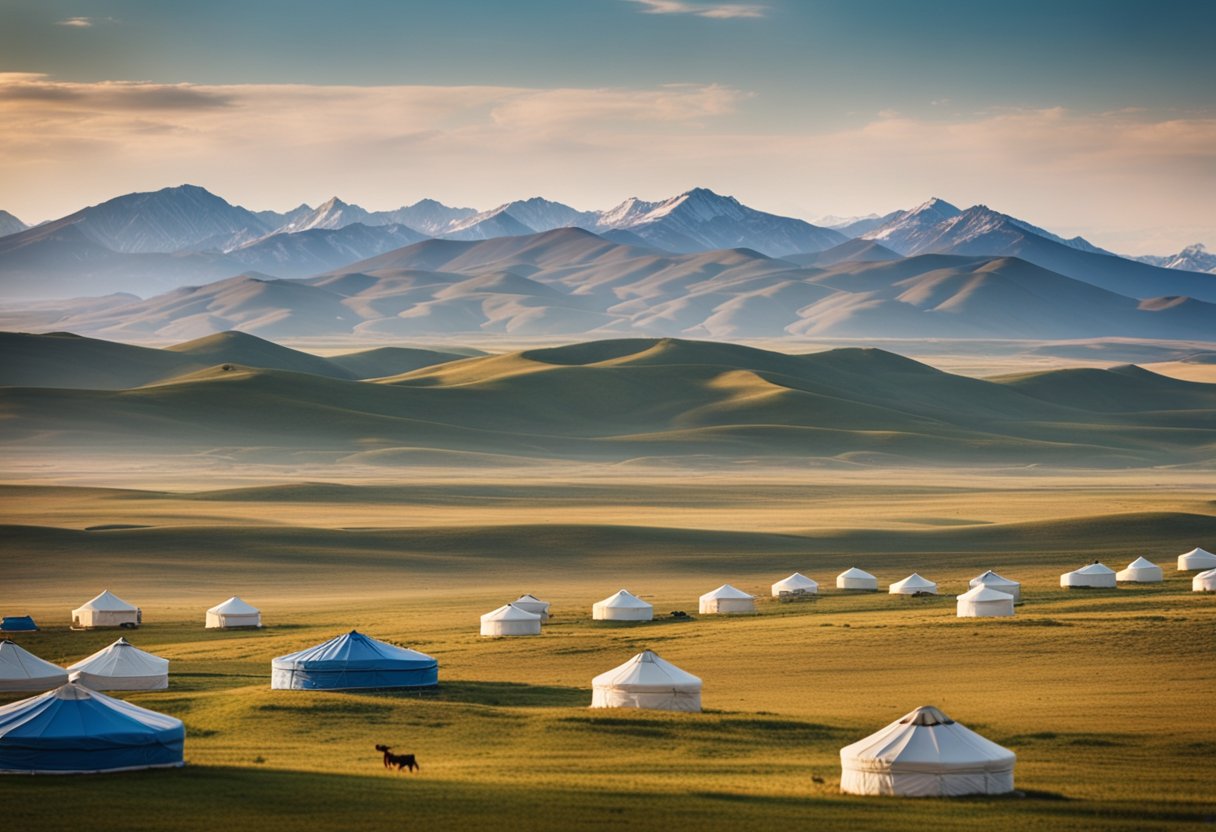
The Mongolian steppe, with its vast expanse and nomadic heart, has nurtured a culture deeply entwined with the rhythms of nature. Nomads, historically, have been custodians of traditions, embracing a self-sufficient lifestyle that reveres the heritage of their ancestors.
Our Efforts to Preserve this Heritage
- Rituals: Celebrated events and long-standing customs provide a sense of identity and community cohesion.
- Arts and Crafts: Nomads produce a variety of hardcover garments and decorative items, vital expressions of their artistic heritage.
- Oral Histories: Stories and epic tales, passed through generations, capture the essence of the Mongolian steppe’s historical narrative.
Preservation Efforts
Preserving the rich cultural tapestry of Mongolian nomads involves:
| Method | Description |
|---|---|
| Documentation | Recording rituals and cultural practices in various mediums. |
| Education | Encouraging local participation and understanding of heritage. |
| Conservation | Protecting tangible and intangible cultural resources. |
Every action we take aims to protect not only the physical embodiments of Mongolian culture but also the intangible elements that compose their unique identity. By fostering a global appreciation of the Mongolian steppe’s living culture, we strive to maintain its vibrancy for future generations.
This dedication to cultural preservation reflects a broader understanding that global heritage is not just a window into the past but a cornerstone of our collective identity and a foundation for future resilience and adaptation.
Contemporary Nomadism and Global Influence
In our exploration of the world’s diverse cultures, we’ve observed that the nomadic peoples of Mongolia have maintained their traditional practices while simultaneously interacting with global influences. Nomadic life remains a defining feature of Mongolian culture, where the skills and rhythms of a pastoral lifestyle continue to be passed down through generations.
Nomadic families frequently engage in horse riding, as horses are integral to daily life on the Mongolian steppe. Herding and transportation, for example, are deeply reliant on equine assistance. Alongside horses, camels also play a crucial role, especially among nomadic groups in the Gobi Desert, where their resilience is indispensable.
Our research indicates a persistent respect for peace within nomadic communities, which often contrasts with the greed that can drive modern society. The equilibrium between taking what is necessary and preserving the environment is a skill honed by necessity, thwarting any need to raid or exploit.
While Mongolia sits at the heart of Asia and is home to a significant population of nomadic peoples, its influence expands well beyond the continent. Through interactions on trade routes like the Silk Road, nomads from Mongolia have historically facilitated cultural exchanges across Asia, disseminating their knowledge and customs.
These exchanges have introduced the wider world to the unique aspects of nomadic culture, from the construction of yurts to the tenets of their way of life. Still, the influence is two-way; modernisation presents both challenges and opportunities for nomadic groups. We focus on providing a deeper appreciation of their adaptive strategies in the face of global change, recognising the strength and resilience these communities exhibit.
Frequently Asked Questions
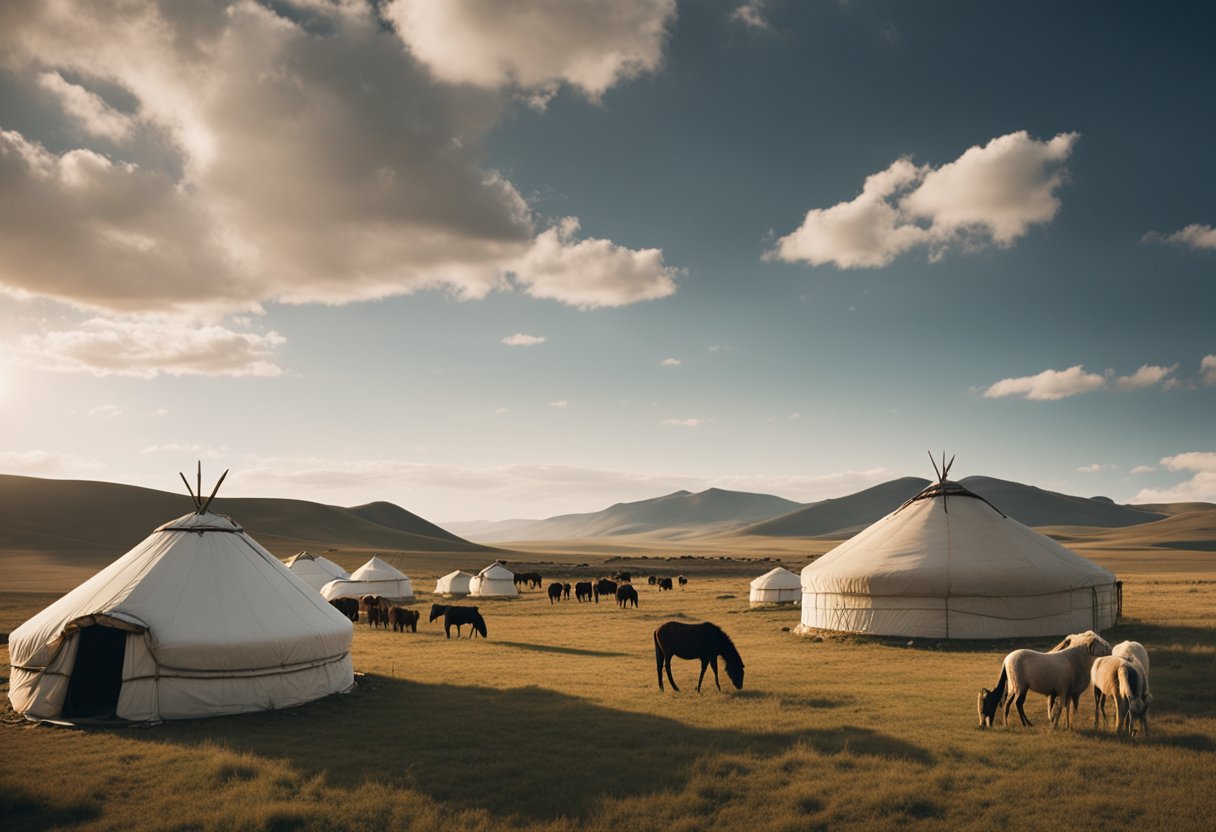
In this section, we answer some of the most commonly asked questions about the nomadic peoples of the Mongolian Steppe, focusing on their traditional way of life and the transitions they face in the modern world.
What motivated the Mongols to expand their territory?
The Mongols were traditionally motivated to expand their territory due to a combination of strategic and survival factors. The need for new pastures for their livestock and the desire to control trade routes played significant roles in their expansion.
How did the nomadic steppe lifestyle influence Mongolian society and culture?
The nomadic steppe lifestyle was integral to Mongolian society and culture. It instilled a deep respect for nature and the importance of mobility. This lifestyle fostered a strong sense of community and adaptability, which are still valued in Mongolian culture today.
What were the primary social classes within the Mongol Empire?
Within the Mongol Empire, the primary social classes included the ruling elite, the aristocracy, and common herders. Their society was relatively egalitarian, with meritocracy playing a key part in the military and administration.
What type of structures did Mongols traditionally live in?
Mongols traditionally lived in “gers,” also known in English as yurts, which are portable, round tents covered with skins or felt, suitable for their mobile lifestyle on the steppe.
Can you describe the traditional nomadic practices still observed in Mongolia today?
Traditional nomadic practices in Mongolia today include herding livestock across the vast steppe, maintaining a diet rich in meat and dairy products, and producing traditional clothing and textiles from animal hides and wool.
How has the transition from nomadism affected modern Mongolian culture and society?
The transition from nomadism has led to more Mongolians settling in urban areas, focusing on education and professional careers. This shift has introduced new societal dynamics while still retaining a strong connection to nomadic heritage and values.




